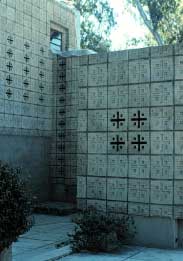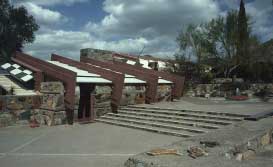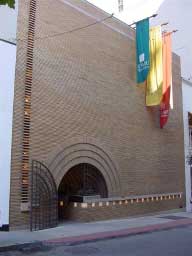|
Frank LLoyd Wright's Works From Around The World
|
||
|
Some of Wright's Most Famous Works
|
||
| Guggenheim | Imperial Hotel | |
|
Taliesin West, one of Wright’s most famous works, is located in Scotsdale, Arizona. It sits on 600 acres and draws thousands of visitors each year. It was designed by Wright and constructed, mostly, by his students beginning in 1937. Wright spent every winter in the house until his death in 1959 (13). Native boulders of red, yellow and gray were used to construct the walls of the home. It has been said that it is Wright’s most dramatic assimilation of building into natural environment. (14). Wright said of the work, “I was struck by the beauty of the desert, by the dry, clear sun-drenched air, by the stark geometry of the mountains, the entire region was an inspiration… And out of that experience, a revelation is what I guess you might call it, came the design for these buildings.” (15). Taliesin West is now the site of the Frank Lloyd Wright School of Architecture
|
||
|
The Johnson Wax Building Company, designed by Wright in 1936, is known more for its interior rather than its exterior. Robert McCarter, in his book Frank Lloyd Wright, stated, “The columned 'great workroom' is one of Wright's most astonishing spaces, surrounded by the light bands in the brick enclosing walls and opened by a series of tubular glass skylights that fill in between the curved tops of the column petals (columns); as Wright said, 'the effect is that of being among the pine trees, breathing fresh air and sunlight’” (16). Located in Racine, Wisconsin, it is still considered today one of Wright’s greatest works.
|

|
|
| The Millard House, located in Pasadena, California, was one of Wright’s pioneering works. Built in 1923, it was the first of four cement textile-block houses that Wright designed in California. It was built with three-inch thick textile blocks stacked side-by-side and atop each other. This, another one of Wright’s pioneering styles, is sometimes referred to as his least attractive. Even Wright himself stated that the textile-blocks were the “cheapest and ugliest things in the building world” (17). |
 |
|
| The V.C. Morris Gift Shop is located in San Francisco, California, and is another example of a simple exterior and a beautifully complex interior. Wright did not include the traditional store-front windows in the gift shop. Instead, he created an arch around the doorway that he claimed would draw people into the store. (18). Although this building was constructed before the Guggenheim, the museum’s design predated that of the gift shop. By constructing the gift shop first, it allowed Wright to experiment with the large, spiral, indoor ramp found in both buildings. | ||
|
|
Wright’s tallest building, the Price Tower, was completed in 1956 and stands 221 feet tall. It was originally conceived for New York City, but was eventually constructed in Bartlesville, Oklahoma. Because of this, Wright often called the building “the tree that escaped the forest” because of resemblance to a tree, with its central “trunk” supporting numerous floors, or “branches” (19). This building is one of Wright’s two vertical structures; the other is the Johnson Wax Building. | |


